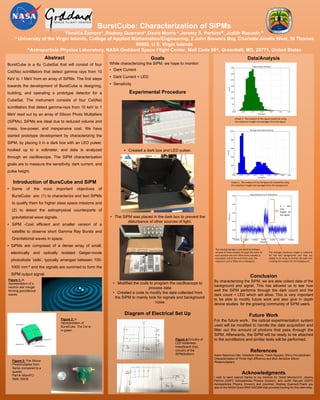
BurstCube Poster Final Draft
- 1. BurstCube: Characterization of SiPMs Ykeshia Zamore⧾ ,Rodney Querrard⧾,David Morris ⧾,Jeremy S. Perkins✽, Judith Racusin ✽ ⧾ University of the Virgin Islands, College of Applied Mathematics/Engineering, 2 John Brewers Bay, Charlotte Amalie West, St Thomas 00802, U.S. Virgin Islands ✽Astroparticle Physics Laboratory, NASA Goddard Space Flight Center, Mail Code 661, Greenbelt, MD, 20771, United States Abstract BurstCube is a 6u CubeSat that will consist of four CsI(Na) scintillators that detect gamma rays from 10 KeV to 1 MeV from an array of SiPMs. The first steps towards the development of BurstCube is designing, building, and operating a prototype detector for a CubeSat. The instrument consists of four CsI(Na) scintillators that detect gamma-rays from 10 keV to 1 MeV read out by an array of Silicon Photo Multipliers (SiPMs). SiPMs are ideal due to reduced volume and mass, low-power, and inexpensive cost. We have started prototype development by characterizing the SiPM, by placing it in a dark box with an LED pulser, hooked up to a voltmeter, and data is analyzed through an oscilloscope. The SiPM characterization goals are to measure the sensitivity, dark current, and pulse height. Introduction of BursCube and SiPM • Some of the most important objectives of BurstCube are: (1) to characterize and text SiPMs to qualify them for higher class space missions and (2) to detect the astrophysical counterparts of gravitational wave signals. • SiPM -Cost efficient and smaller version of a satellite to observe short Gamma Ray Bursts and Gravitational waves in space. • SiPMs are composed of a dense array of small, electrically and optically isolated Geiger-mode photodiode ’cells’, typically arranged between 100- 1000 mm-2 and the signals are summed to form the SiPM output signal. Figure 3: The Silicon Photomultiplier from SensL compared to a quarter. Part #: MicroFC- SMA-10035 Figure 2: A representation of BurstCube. The CsI is in green. Goals While characterizing the SiPM, we hope to monitor: • Dark Current • Dark Current + LED • Sensitivity Experimental Procedure • Created a dark box and LED pulser. • The SiPM was placed in the dark box to prevent the disturbance of other sources of light. • Modified the code to program the oscilloscope to process data • Created a code to modify the data collected from the SiPM to mainly look for signals and background noise Diagram of Electrical Set Up Data/Analysis Conclusion By characterizing the SiPM, we are able collect data of the background and signal. This has allowed us to see how well the SiPM performs through the dark count and the dark count + LED which will allow. This is very important to be able to modify future work and also give in depth device studies for the growing community of SiPM users. Future Work For the future work, the optical experimentation system used will be modified to handle the data acquisition and filter out the amount of photons that pass through the SiPM. Afterwards, the SiPM will be ready to be attached to the scintillators and similar tests will be performed. References Adam Nepomuk Otte, Distefano Garcia, Thanh Nguyen, Dhruv Purushotham. Characterization of Three High Efficiency and Blue Sensitive Silicon Photomultipliers. Acknowledgments I wish to send special thanks to my mentors Dr. David Morris(UVI) ,Jeremy Perkins (GSFC Astroparticles Physics Division), and Judith Racusin (GSFC Astroparticles Physics Division) and coworker, Rodney Querrard.Thank you also to the NASA Grant NNX13AD28A that provided funding for this internship. Figure 1: A representation of a neutron star merger forming gravitational waves. Figure 4:Circuitry of LED solderless breadboard (top), circuitry of the SiPM(bottom) h = the max height of the signal The average maximum height is collected for the two backgrounds and they are added to an array to format the data into creating the analysis for the background. The moving average is calculated by sliding a window of three samples through the trace. At each position the sum ofthe three samples is calculated, and at the end of the scan, the maximum sum is filled into a histogram. Graph 2: The analysis of the background created by using the maximum height and averages form the background. Graph 1: The analysis of the signalcreated by using the maximum height and averages form the signal.
Editor's Notes
- I haven’t included the references but I know which one’s I’m going to use.